Rodent control Services in Vancouver
Protect Your Home from Health Risks with Expert Rat Control
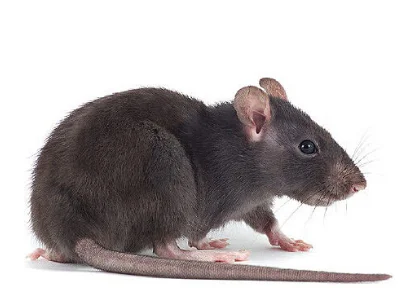
Effective rodent control starts with a comprehensive inspection to assess the infestation’s severity. Based on the findings, our technicians will develop tailored solutions to effectively trap, remove, and seal off entry points to prevent further infestations.
Vancouver faces ongoing issues with rodent infestations, primarily from Norway rats, which can inhabit basements, crawlspaces, walls, and attics. Homeowners may notice signs of infestation such as rodent feces or unusual sounds. Beyond being nuisances, rodents can pose health risks by transmitting diseases and increasing fire hazards through gnawing on electrical wires, while also introducing parasites such as fleas.
Home Inspection for Rodents
A 1st Pest Control technician will conduct a comprehensive inspection of your property and perform a thorough exterior inspection of your home to check for signs of rodents. Common indicators of rodent activity include chewing marks, droppings, rub marks, nesting material, and small entry points.
The most frequent places to discover a rodent infestation are in the attic, crawlspace, and inside the walls. Evidence of rats and mice is often found in the kitchen as they search for food.
At 1st Pest Control, we understand the importance of keeping your home or business safe from mice and rats. That’s why we offer comprehensive rodent control programs and exclusion services to help you seal all entry points and prevent these unwanted pests from entering your home.
Introducing Ekomille: A Sustainable Approach to Rodent Control
At 1st Pest Control, we are committed to effective and environmentally friendly pest management solutions. That’s why we are proud to introduce Ekomille as part of our comprehensive rodent control services.
Ekomille is an innovative bio-pesticide device designed to help control large rodent populations without the use of harmful chemicals. It harnesses natural predatory behaviour to control rodents effectively and sustainably.
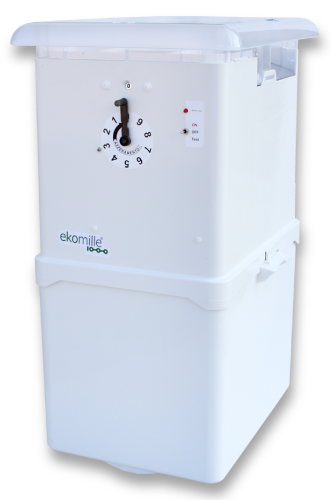
How does Ekomille Work?

- Ekomille is setup in an area where rodents are a problem. “Explorer” rodents, usually the first to investigate new things, are lured by food placed in the Ekomille’s bait compartments.
- Once an explorer rodent checks out the device and finds no danger, it signals to the rest of its colony that Ekomille is a safe and reliable food source.
- After this initial exploration phase, Ekomille is activated.
- It then transforms from just a food dispenser into an active trapping device. From that point on, whenever a target rodent attempts to feed from the central dispenser, an electromechanical mechanism is triggered, and the rodent is captured.
- The captured rodents are kept in a sealed lower section of the device, which prevents them from contaminating the environment.
Benefits of Ekomille
- Environmentally Friendly: Ekomille operates without the need for toxins or poisons, making it safe for both the environment and non-target species.
- Efficient: This automated device works around the clock, continuously capturing and neutralizing rodents, ensuring a proactive approach to pest control.
- Low Maintenance: With minimal upkeep required, Ekomille offers a hassle-free solution that integrates seamlessly into your existing pest management strategy.

New to 1st Pest Control?
Enjoy 10% OFF your first treatment service.
Enter Code NEW10 in the contact form

Ready to Rid Your Home of Pests? Contact 1st Pest Control Now for Expert Treatments.
Request a free, no-obligation estimate today
Trusted rat and mice control in Vancouver since 2005

Guaranteed Safety
Bait stations are an essential tool for pest control, but it’s crucial to prioritize safety when using them around family and pets. When setting up bait stations, our technicians will ensure they are placed strategically to avoid accidental ingestion or exposure to toxic chemicals.

Guaranteed Protection
Our basic mouse control program consists of three scheduled visits within three months.

Exclusion work is a crucial step in mouse control that involves detecting and sealing all entry points and exclusion areas to prevent mice from entering your home, such as loose or missing shingles, gaps around chimneys and vents, cracks in the fascia board or soffit, cracks in the foundation or walls, gaps around pipes, electrical outlets or switches.
Learn from what others ask us about rodent control
What are effective home strategies for rodent prevention?
Sealing up holes and removing food sources are key strategies for preventing rodent infestations. Regular inspections can identify potential entry points and nesting sites, helping to keep homes rodent-free.
Are there any natural deterrents effective against rodents?
Natural deterrents such as peppermint oil, and maintaining cleanliness by removing food and water sources, can be effective in repelling rodents. However, these should be part of a comprehensive rodent control plan.
Can professional rodent control services offer long-term solutions?
Professional rodent control services can provide long-term solutions by identifying and sealing entry points, setting up traps, and advising on preventive measures to ensure rodents do not return.
What should I do if I find a rodent nest in my home?
Avoid disturbing the nest and contact pest control immediately. They can remove the nest safely and provide sanitation advice to prevent future occurrences.
Other Less Frequently Found Rodents
In addition to rat and mouse control, 1st Pest Control in Vancouver offers effective pest management services for a variety of other troublesome rodents, including gophers, prairie dogs, voles, and moles. Each of these pests poses unique challenges and risks to properties, and our team is equipped with the knowledge and tools to address these infestations effectively.

Gophers
- Gophers are burrowing rodents known for their extensive tunnel systems that can damage lawns, gardens, and landscaping.
- They feed on roots and tubers, often leading to the decline of plants and even trees.
- Signs of a gopher infestation include mounds of soil pushed up from their burrows and visible damage to vegetation.
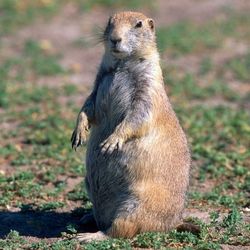
Prairie Dogs
- Prairie dogs are sociable rodents that live in colonies and create extensive underground networks.
- They can damage turf, crops, and gardens, and pose risks to local ecosystems due to their burrowing habits.
- Their burrows can create hazards for pets and livestock.
- We implement humane removal methods to manage prairie dog populations effectively.

Voles
- Voles, often referred to as field mice, are small rodents that thrive in grassy areas and gardens.
- They feed on grasses, roots, and seeds, and their burrowing activity can disrupt lawns and garden beds.
- Vole tunnels can often be seen in the form of surface trails in the grass.
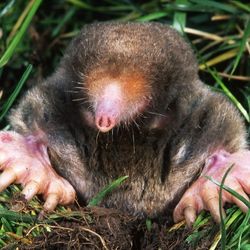
Moles
- Moles are unique rodents that primarily burrow underground in search of insects and worms.
- They can create unsightly mounds and tunnels in the yard, disrupting the aesthetic appeal of lawns and gardens.
- Moles indirectly cause damage by affecting soil structure and leading to root problems in plants.
Request a free, no-obligation estimate today
Rats and mice FAQs
What's the difference between Norway and roof rats?
Differentiating between Norway rats (Rattus norvegicus) and roof rats (Rattus rattus) can be done by examining several physical and behavioural characteristics:
- Size and Body Shape:
- Norway rats are typically larger and heavier, with a more robust body compared to roof rats.
- Roof rats are sleeker and smaller in comparison, with a more slender body.
- Head Shape:
- Norway rats have a blunt, rounded snout.
- Roof rats have a more pointed, triangular-shaped snout.
- Ears:
- Norway rats have smaller ears relative to their body size.
- Roof rats have large ears that are prominent and extend beyond the fur.
- Tail Length:
- Norway rats have shorter tails, usually shorter than their body length.
- Roof rats have long, thin tails that are longer than their body length.
- Fur Colour:
- Norway rats typically have brown or grey fur on their backs and a lighter underside.
- Roof rats may have darker fur on their back and a lighter underside, but their fur colour can vary widely.
- Habitat:
- Norway rats are ground-dwelling rodents that tend to burrow and live in underground tunnels, sewers, and basements.
- Roof rats are agile climbers and are often found nesting in higher areas such as trees, attics, rafters, and the upper floors of buildings.
Observing these characteristics, along with the location and behaviour of the rodent, can help in determining whether it is a Norway rat or a roof rat.
| Roof rat | Norway Rat |
|---|---|
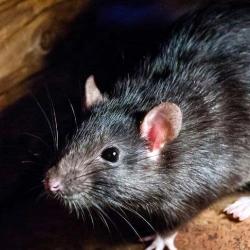 |
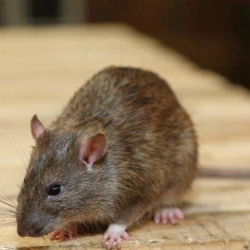 |
Can rats or mice make me or my family sick?
Yes. Proper rodent control is needed to protect yourself, as they are a well-known carrier of diseases which may be easily transmitted to humans. Diseases they are associated with include, but are not limited to, hantavirus pulmonary syndrome, lestospirosis and rat-bite fever. These diseases are transmitted through direct contact, or the inhalation or consumption of contaminated items. Infected ticks carried by these rodents may also spread diseases to humans with devastating effects.
For example, rats carrying infected ticks caused the spread of the bubonic plague, otherwise known as the Black Death, in Europe that killed half the population during the Middle Ages. Other than physical illness, infestations have been known to affect the emotional and psychological well-being of the homeowner or tenant.
How to safeguard your property from mice and rats?
Answer:
Seal entry points: Check for cracks, gaps, and holes around your house, especially near windows, doors, and utility pipes. Seal them with caulk, steel wool, or other suitable materials. This will prevent rodents from entering your home.
Keep indoor areas clean: Rodents are attracted to food sources and shelter. Maintain a clean kitchen and avoid leaving food uncovered or accessible. Regularly clean up spills, crumbs, and garbage.
Store food properly: Keep all food, including pet food, in sealed containers made of metal or glass. Rodents can easily chew through plastic containers.
Dispose of garbage properly: Use sealed garbage bins and regularly dispose of trash. Keep outdoor garbage away from the house and ensure that bins have tight-fitting lids.
Secure possible nesting areas: Remove clutter and potential hiding spots in basements, attics, and storage areas. Seal openings and gaps to prevent rodents from nesting.
Trim trees and shrubs: Keep trees and shrubs trimmed away from your house to prevent rodents from using branches as access points to your home.
Maintain a tidy yard: Keep the yard well-maintained and free from debris, such as woodpiles or old furniture, where rodents can hide or nest.
Install screens and caps: Use wire mesh screens on vents, chimneys, and other openings that could serve as entry points for rodents. Ensure all openings are covered with tight-fitting caps or screens.
Keep the garage organized: Rodents often find their way into the garage. Store items in plastic bins instead of cardboard boxes, as rodents can easily chew through them. Avoid leaving the garage door open for extended periods.
Inspect periodically: Regularly inspect your house and surroundings, especially during the winter months when rodents seek shelter. Look for signs of droppings, gnaw marks, or any other indications of rodent activity.
Seek professional help: If the rodent problem persists or becomes unmanageable, consider contacting a professional pest control company such as 1st Pest Control for assistance. They can evaluate the situation and provide effective solutions.
Where will I generally find rats and mice in my home or business?
Rats and mice are primarily nocturnal creatures by nature. They tend to nest or sleep in dark and quiet corners and crevices of a building’s structure, such as in the roofs, basements, attics and walls. Storage units or cluttered areas are also ideal hiding places for these rodents.
Where do rats and mice come from?
Rats and mice are generally very small and can easily enter a residence through small, obscure openings. In fact, mice can enter a home through an opening the size of dime, where rats only require an opening as small as a quarter.
Point of entry may include entrances, windows, and through the cracks and crevices along walls and floors. Rats and mice are attracted to warm places with easy access to food and water and they feed on a variety of organic material, including both plant and protein-based products.
As a result, an occupied residence is an ideal place for them to survive and breed rapidly
What damage can they cause to my property?
Rats and mice are notorious for causing damage in homes or businesses. Tooth marks from gnawing or chewing can be found on various surfaces and items they come in contact with. The primary reason for damage is because a rodent’s front teeth does not stop growing.
As a result, it must continuously gnaw on objects to keep its teeth filed down. Without rodent control, these pests will continue to feed and nest, causing damage to your property.
Their jaws are very strong and can chew through walls, soft concrete, wiring and pipes. These activities may lead to structural damage and create electrical and fire hazards. Droppings and urine left behind contaminate surfaces and food exposed to these rodents are no longer safe for human consumption and must be thrown away.
Why do I have to get rid of them?
- Rats and mice cause damage to the content or structure of a property that may be very costly to fix or replace. In addition, they are carriers of diseases that can be transmitted to humans simply by being in direct or indirect contact with the rodents or their wastes.
- Rats and mice breed rapidly and with a greater population comes increase risk to the health and safety of occupants.
- Mice can damage wires, books, plastics, aluminum cans, drywall, insulation, siding, and wallboards
What are the benefits when comparing the three and 12-month rodent control programs?
- Comprehensive and sustained protection: The 12-month program offers extended protection against rodent re-infestation, ensuring that the house remains rodent-free for a longer period compared to the shorter 3-month program.
- Continuous monitoring and prevention: With the 12-month program, homeowners receive ongoing monitoring and preventive measures to detect and address any potential rodent issues before they become a full-blown infestation.
- Greater peace of mind: Knowing that their home is protected and monitored for a longer duration can provide homeowners with increased peace of mind, eliminating worries about rodent problems.
- Cost efficiency: The 12-month program proves to be a more cost-effective option as it provides sustained rodent control at a lower cost per month compared to the shorter program.
- Time savings: By opting for the 12-month program, homeowners can save time and effort in dealing with multiple instances of rodent infestation and can focus on other aspects of home maintenance and well-being.
These benefits make the 12-month program a highly advantageous choice for homeowners, ensuring long-lasting, efficient, and cost-effective rodent control.
Is there a link between rodents and the bubonic plague?
The bubonic plague, also known as the Black Death, is a highly contagious and deadly disease that ravaged Europe in the 14th century, resulting in the deaths of millions of people. One of the key links between rodents and the bubonic plague is the role that rats and fleas played in spreading the disease. Rats were the primary carriers of the bacteria that caused the plague, while fleas served as the vectors that transmitted the disease from rats to humans.
Rats were able to spread the bubonic plague to humans through their fleas, which would bite infected rats and then bite humans, transferring the bacteria in the process. The unsanitary living conditions of medieval cities, combined with the large numbers of rats present, created the perfect breeding ground for the bacteria to spread rapidly among both rats and humans. As a result, the bubonic plague was able to decimate entire populations in a matter of months, leading to widespread death and destruction.
The link between rodents and the bubonic plague is not limited to historical instances, as outbreaks of the disease continue to occur in various parts of the world today. In regions where sanitation is poor and rat populations are high, there is a heightened risk of the bubonic plague resurfacing. Efforts to control rat populations and improve sanitation practices are crucial in preventing the spread of the disease and protecting public health.
In conclusion, the link between rodents and the bubonic plague is clear and significant, as rats and fleas played a crucial role in spreading the disease throughout history. Understanding this link and taking proactive measures to control rat populations and improve sanitation practices are essential in preventing future outbreaks of the bubonic plague. By addressing the root causes of the disease, we can help to ensure the health and well-being of populations around the world.


